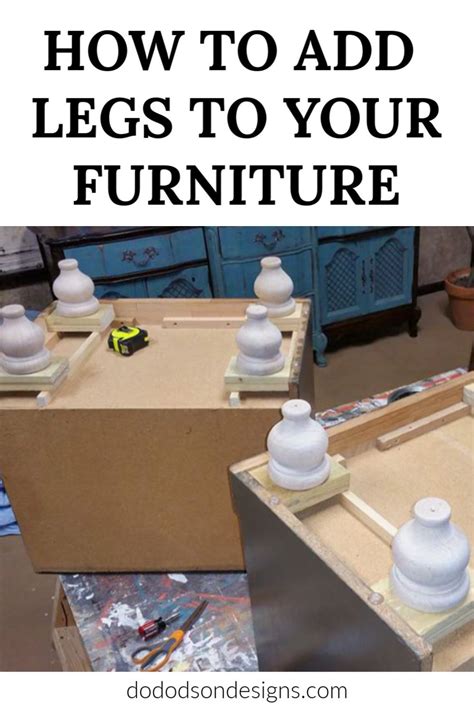How to Add Legs to Furniture: A Simple Guide
Adding legs to furniture can completely transform its look and functionality. Whether you're raising a low-slung coffee table, giving a new life to an old chest, or simply wanting to change the style of a piece, this guide will walk you through the process, offering tips and tricks for a successful outcome. This isn't just about adding height; it's about enhancing both aesthetics and practicality.
Why Add Legs to Furniture?
There are several compelling reasons to add legs to your furniture:
- Increased Height: Raising furniture can improve ergonomics, making it more comfortable to use. A higher coffee table makes it easier to reach, while raised beds are easier to get in and out of.
- Improved Aesthetics: Legs can drastically change the style of a piece. Adding sleek metal legs to a wooden chest can create a modern industrial look, while ornate wooden legs can add a touch of classic elegance.
- Enhanced Functionality: Adding legs can provide better airflow beneath furniture, preventing dust accumulation and dampness. This is particularly beneficial for upholstered pieces.
- DIY Project: It's a relatively straightforward project that allows you to personalize your furniture and save money compared to buying new.
- Accessibility: Raising furniture can significantly improve accessibility for people with mobility issues.
What You'll Need:
Before you begin, gather the necessary tools and materials. The specifics depend on the type of furniture and the legs you choose, but generally, you'll need:
- Furniture Legs: Choose legs that complement your furniture's style and size. They come in various materials (wood, metal, plastic), heights, and styles.
- Measuring Tape: Accurate measurements are crucial for a successful outcome.
- Pencil: Mark placement points for the legs.
- Drill: Necessary for attaching most furniture legs.
- Screws: Select screws appropriate for the material of your furniture and legs. Consider using wood glue for added strength and stability.
- Level: Ensure your furniture remains level and stable after attaching the legs.
- Screwdriver (or drill bit matching screw size): For driving the screws into place.
- Safety Glasses: Protect your eyes from flying debris.
- Wood Glue (optional): Provides extra strength and prevents the wood from splitting.
- Sandpaper (optional): For smoothing any rough edges.
How to Add Legs to Furniture: A Step-by-Step Guide
1. Planning and Measurement:
- Measure carefully: Determine the desired height of your furniture and the length of the legs needed to achieve it.
- Choose leg placement: Decide where the legs will be placed. For even weight distribution, it's usually best to have legs at each corner. Mark the locations with a pencil.
- Consider weight distribution: For heavier pieces, you might need additional support or stronger legs.
2. Attaching the Legs:
- Pre-drill pilot holes (recommended): This prevents the wood from splitting when screwing in the legs.
- Apply wood glue (optional): Apply a small amount of wood glue to the leg and the furniture before attaching. This adds strength and prevents the wood from splitting.
- Attach the legs: Use the appropriate screws to attach the legs to the marked locations. Ensure the legs are securely fastened.
- Check for level: Use a level to ensure the furniture is level after attaching the legs. Adjust as needed.
3. Finishing Touches:
- Fill any screw holes: Use wood filler to fill any visible screw holes and sand smooth.
- Refinish or paint (optional): You can refinish the furniture or add a fresh coat of paint to match the new legs.
Choosing the Right Furniture Legs
What materials are furniture legs made of? Furniture legs are commonly made from wood (various types like oak, pine, or maple), metal (steel, iron, aluminum), or plastic. Wood legs offer a classic, traditional look, while metal legs provide a more modern or industrial aesthetic. Plastic legs are often more affordable and lightweight.
How do I determine the appropriate height for my furniture legs? The ideal leg height depends on the type of furniture and your personal preference. Consider the existing height, intended use, and desired aesthetic. Referencing similar furniture pieces can give you a good starting point.
Where can I buy furniture legs? Furniture legs are widely available from online retailers like Amazon, Etsy, and specialized woodworking stores. Local hardware stores may also offer a selection.
Troubleshooting and Tips
- Uneven surfaces: If your floor is uneven, use adjustable leg levelers to ensure stability.
- Over-tightening screws: Avoid over-tightening screws, as this can strip the wood or damage the legs.
- Weight capacity: Choose legs with a weight capacity suitable for your furniture.
By following these steps and considering the tips provided, you can successfully add legs to your furniture, transforming an existing piece and creating a unique, personalized design. Remember safety first – always wear safety glasses when using power tools.

